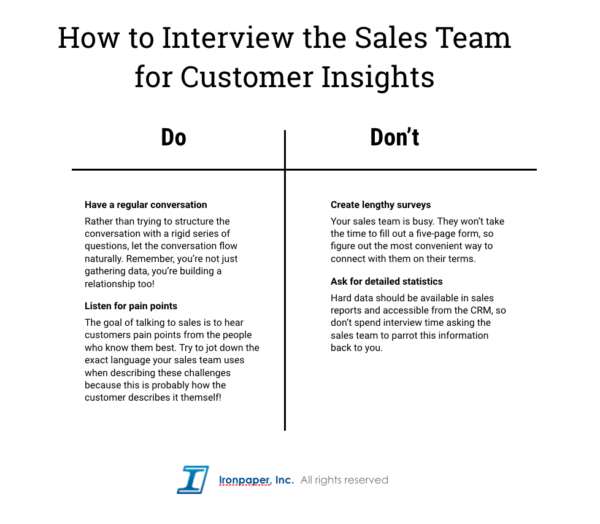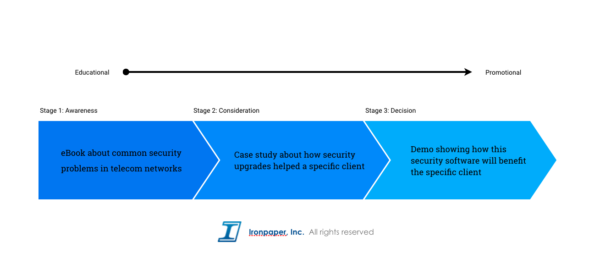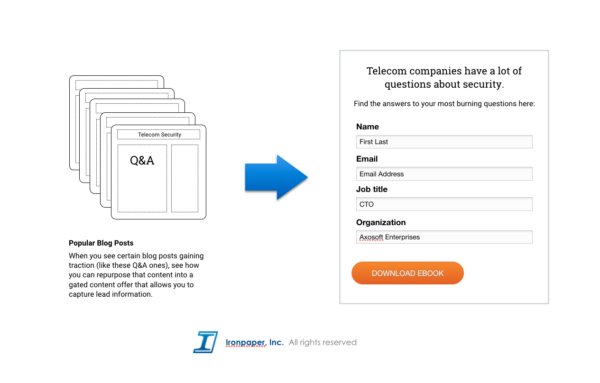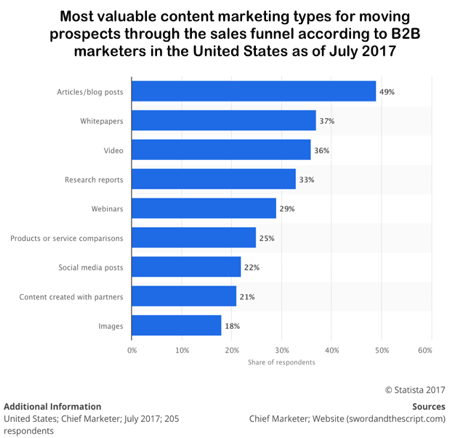
Article by the Ironpaper team.
Content marketers, beware: The people who buy technology products and services don’t care how many awards your company has won or how long you’ve been in business.
Buyers crave valuable, educational content that helps them overcome challenges and make difficult decisions quickly. When content marketers focus on fixing buyers’ problems -- rather than features and technologies -- they establish more trust and their content resonates with buyers.
Why is this important?
Trust makes the buyer eager for more insightful information, which increases the likelihood they will become a sales qualified lead and, eventually, a paying customer.
Nearly half of buyers view 3-5 pieces of content before engaging with a sales rep
Early in the sales process, people want to research on their own. That’s why 47% of buyers view three to five pieces of content before engaging with a sales representative1. To capitalize on this pattern, B2B tech companies with complex SaaS, IoT or IT products need to develop assets that speak to leads where they are in the buyer’s journey.
The best way to keep customers engaged through a long sales process is to build a relationship that is laser-focus on their needs. That’s why the rest of this article shows you how to deliver content leads will embrace in five, strategic steps.
As you begin the content development process, it’s crucial for content marketers to learn from the sales teams who interact directly with leads every day and the easiest way to capture those insights is in an interview session.
If that sounds daunting, it shouldn’t be. Don’t get caught up in asking the “right” questions or creating a lengthy survey. Instead, just talk with them. The goal is to leave the meeting knowing who the best leads are (in terms of title, company size, etc.) and understanding how they describe their challenges in specific language. Armed with these profiles and pain points, the marketing team will be better equipped to create more relevant problem-solving content.

For example, insights from a salesperson may inform marketers that one potential buyer persona is a telecom service provider whose customers are leaving the business because the network isn’t secure enough. In this case, the buyer is looking for new software to make their network more secure, so the business can rebound.
Thanks to their conversation with sales, marketing knows the buyer wants a primer about general security problems that affect telecom networks before he or she starts researching which type of software to buy.
There are three stages of the buyer's journey: awareness (they’ve never heard of your brand), consideration (they’re comparing you to competitors), and decision (they’re almost ready to pull the trigger on a purchase). When the marketer for this telecom security software provider is creating their content strategy, they should approach it by creating valuable content and insights for each stage, in order. That way the target buyer gets educated before being rushed into a purchasing decision, which builds trust in the company. A few content ideas for that fictional marketer might be:

Before scaling up content efforts, marketers should test various formats -- blogs, ebooks, white papers, webinars -- and different subject matter to determine what buyers are most receptive to. For example, after writing three blog posts -- a list of recommendations, a how-to, and a Q&A -- content marketers should analyze the data to determine which type generates the most buyer interest. If the blog that’s structured like a Q&A generates the most marketing leads, it makes sense to produce more Q&A blogs that can be collected and reformatted as something else, like an eBook or white paper.
That said, this information doesn’t mean all recommendations and how-to blogs don’t convert. Instead, it simply means those styles need more tweaking to resonate with website visitors on the same level. Keep experimenting and measuring results to find out what really works for the target market.

Once the content team has a sense of what’s working, it’s time to generate a consistent flow of blogs and articles since 49% of business-to-business marketers say these are the most valuable types of content marketing for moving prospects through the sales funnel.

The more relevant and insightful the content is, the more effective it will be at solving buyers’ problems, establishing their trust, and converting them into sales qualified leads. Airtight alignment on content strategy between sales and marketing is essential to content marketing effectiveness in generating sales qualified leads.
Airtight alignment on content strategy between sales and marketing is essential to content marketing effectiveness in generating sales qualified leads.
The more B2B tech companies combine the knowledge and skills of sales and marketing professionals to create valuable content, the more helpful the content will be for buyers. Like many aspects of successful business, this needs to be a team effort with sales and marketing working together to help buyers overcome obstacles.
It’s still not enough to create helpful content for solving buyers’ problems. Follow-up is needed. B2B tech providers should measure the content’s effectiveness by studying which keywords generate the most sales qualified leads. If buyers consume more blogs than white papers, figure out why.
Seek to understand what it was about the white paper content that resonated more with buyers than the blog. Analyzing this can help fine-tune the next piece of content. If one blog headline generated a lot more leads than several others, try to figure out why. Armed with these new insights, create more targeted content.
From there, adjust your content strategy and keywords based on what you learn. Be pragmatic. Do what works. Shelve what doesn’t. Test early and often. Iterate early and often. Use data to make better decisions about what content to produce that solves buyers’ problems. Then, add fuel to the fire of great content with paid ads to drive even more traffic.
Sources:
by Jonathan Franchell, CEO of Ironpaper - For more tips and hacks: Need to remove a new line after h1 tags? Both web designers and SEO practitioners need to employ headline tags: H1, H2, H3 in several ways to improve web page structure and tag...

The Crowded Arena of the IT Marketplace Updated December 2024 The Information Technology (IT) landscape is experiencing rapid growth and intensifying competition. IT spending is projected to reach nearly 5.1 trillion U.S. dollars in 2024, a...

Updated December, 2024 The field of digital marketing is evolving rapidly in response to new technology and changing buyer expectations. To help career-minded marketers, we’ve rounded up the top 10 skills needed to succeed in the field. These are...
